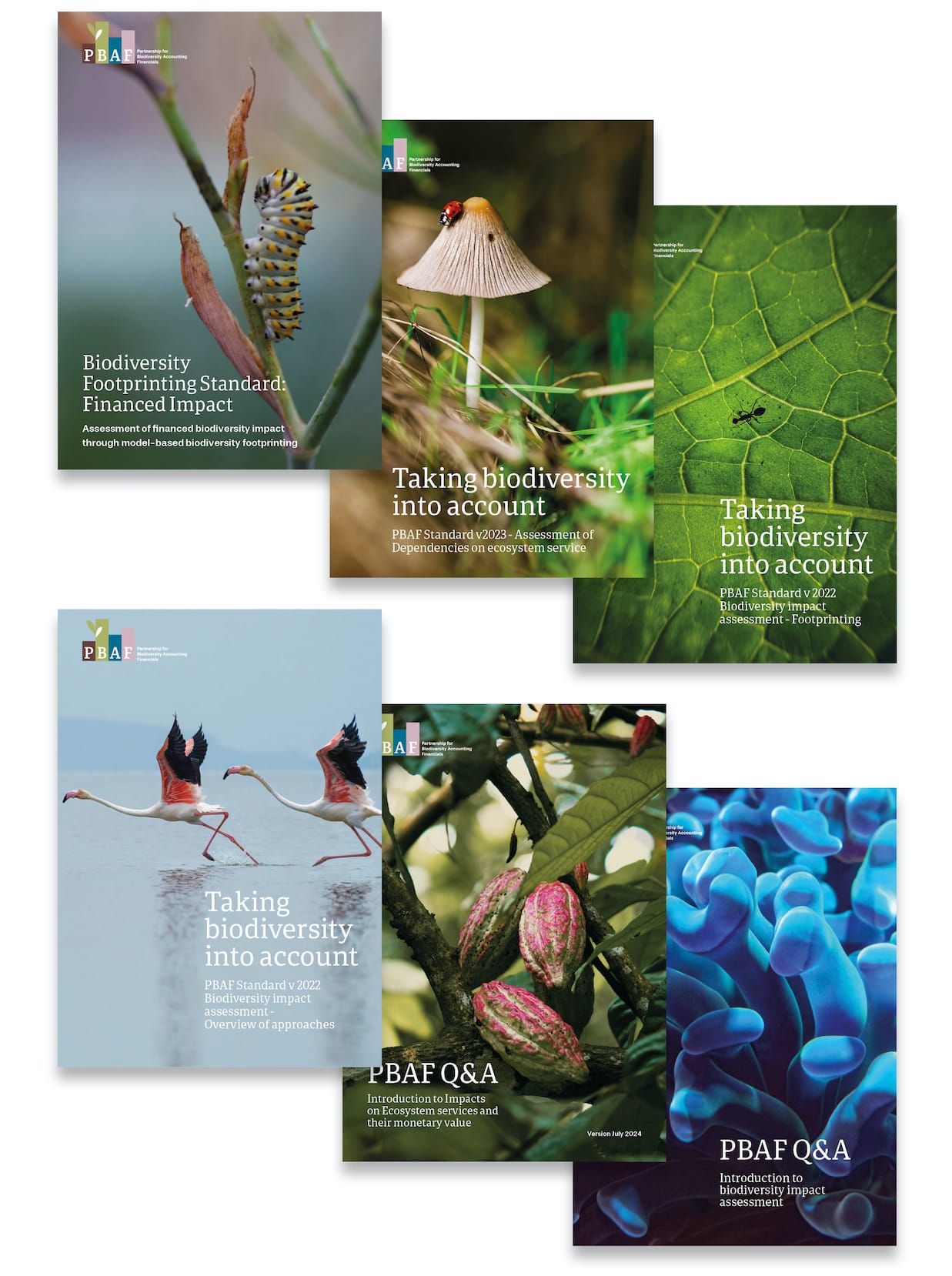
How can financial institutions reduce their negative impact on global biodiversity and work towards biodiversity restoration? A question that the Partnership for Biodiversity Accounting Financials (PBAF), an international partnership of banks, asset managers and investors, has been working on for several years.
PBAF offers a new and free standard for financial institutions to measure the impact of loans and investments on biodiversity. According to PBAF, every bank, asset manager or pension fund can use this to measure and take action in a targeted way towards reducing their negative impact, and protecting and restoring biodiversity. The PBAF participants call on other financial institutions to join them and work together towards a single global approach for the financial sector.
Biodiversity Footprinting Standard: Financed Impact [pdf]
The focus of the ‘Biodiversity Footprinting Standard: Financed Impact’ is on model-based biodiversity footprinting. The Standard is an update of and replaces the ‘PBAF Standard v2022– Biodiversity impact assessment – Footprinting’. The updated standard is based on discussions with PBAF partners in the PBAF working groups and feedback from the PBAF Sounding board, including data providers, nature conservation organisations and other experts on biodiversity impact and dependency assessment.
Model-based biodiversity footprinting is used in the financial sector to assess the potential impact on biodiversity at the level of a portfolio, asset class, company or project. Footprinting results can be used to decide on materiality, and to support due diligence, active ownership and disclosure. The objective of the standard is to safeguard the quality of biodiversity footprinting and to contribute to harmonization and mainstreaming. The PBAF standard is aligned with the PCAF standard for Financed Emissions (supporting carbon accounting) to the extent possible.
PBAF encourages tool developers, data providers and financial institutions to align and harmonise approaches, meeting the PBAF requirements and recommendations presented.
This Standard provides guidance on the steps in a dependency assessment and includes PBAF requirements and recommendations for financial institutions and data providers. The results of a dependency assessment can feed into the ‘Evaluate’ step of TNFD’s LEAP approach (Locate-Evaluate-Assess-Prepare) and into CSRD (Corporate Sustainability Reporting Directive) and GRI (Global Reporting Initiative) disclosures.
Finance & Nature Toolbox v1.0 [pdf]
In the last few years, a growing number of biodiversity impact & dependency assessment tools have seen the light of day, including well known tools like IBAT and ENCORE. Many financial institutions have taken first steps to conduct an impact assessment on portfolio level to identify potential impact hotspots and decide on next steps, either or not for disclosure purposes or to manage (potential) nature-related financial risks and opportunities.
At the same time, with the growing number of tools and publications, it is becoming more difficult to keep track and to understand what tools to use for what purpose and when. This is exactly what the PBAF Finance & Nature Toolbox is trying to address: What questions do financial institutions try to answer in different steps of the loan and investment process and which tools, databases and publications can support them in answering these questions?
Of course, a toolbox like this will never be complete. The toolbox focuses on a (subjective) selection of tools that we see are being used in practice by financial institutions and also includes a selection of databases and publications that can be practical resources in answering questions.
The toolbox is developed for asset owners, asset managers, impact investors and commercial banks. Not yet for insurers, although the insurance sector plays an important role in addressing biodiversity loss. The toolbox may be expanded to this sector in future updates.
The PBAF Q&A Impact on ESS [pdf]
This Q&A document provides answers to 10 questions regarding an
assessment of impacts on ecosystem services (ES) and the value of
these services. Explaining what it means, why it matters and how it
works.
Additional (background) information on this topic can be found in the publication ‘Impact on Ecosystem Services – A Return on Investment’.
Impact on Ecosystem Services – A Return on Investment [pdf]
Q&A- Introduction [pdf]
Offering an introduction to biodiversity impact assessment for financial institutions in sixteen questions and answers.
Target group: Financial institutions & impact investors that are just starting to orientate themselves on biodiversity impact assessment.
Footprinting [pdf]
Presents PBAF’s view on biodiversity footprinting: what does a biodiversity footprint need to comply with to provide the right information to financial institutions. Includes requirements and recommendations.
Target group: Financial institutions & impact investors with some experience on impact assessment, data providers and tool developers
Nature and nature-related (financial) risks and opportunities are increasingly gaining attention in the financial sector.
Overview of approaches [pdf]
Provides
an overview of different biodiversity impact assessment approaches that
can be used by financial institutions and includes a chapter on
‘Positive impact’.
Target group: Financial
institutions & impact investors that have limited knowledge and
experience, to more experienced financial institutions & impact
investors
Biodiversity Disclosure for the financial sector [pdf]
The PBAF Guidance note ‘Biodiversity Disclosure for the financial sector: pathways towards compliance’ offers guidance on the main disclosure requirements of CSRD ESRS E4, SFDR, Article 29 LEC and TNDF, the data need and the impact and dependency assessment tools that can be used in the compliance and disclosure process. This guidance note was last updated end of 2024 and does not consider any changes in European disclosure regulation following the Omnibus Simplification Package.

Roel Nozeman, Senior Advisor on Biodiversity at ASN Bank and PBAF Programme Director, presents the report on behalf of the PBAF participants.
Biodiversity is under severe pressure worldwide. And yet our society and economies are highly dependent on the functions that nature provides. The financial sector has a crucial role to play in reducing damage to biodiversity and in guiding the sustainable use, protection and restoration of nature. Being able to measure our impact on biodiversity is an important prerequisite for fulfilling this role. The report we are presenting today gives banks, asset managers and pension funds the insights they need to get started on this right away. It is an invitation to all financial institutions worldwide to join us in building a sustainable future.
The 'PBAF Standard' describes by way of requirements and recommendations what is needed to carry out a biodiversity footprint: an assessment for financial institutions to measure, manage and report on the negative and positive impact of their loans and investments (e.g. shares, bonds and green bonds) on biodiversity. For example, fund managers can estimate the loss of biodiversity from an investment in an international food company and gain insight into the underlying causes.
Besides important preconditions, the standard explains various methodologies and tools that financial institutions can use to map out their impact. Innovative examples are the use of satellite images to map deforestation and the detection of certain animal species through DNA traces in rivers.
The standard is harmonized as much as possible with other initiatives in the financial sector, such as the Taskforce for Nature Related Disclosures (TNFD), the Science Based Targets Network (SBTN) and the EU Align project.
A PBAF Sounding Board with experts in the field of biodiversity impact and dependency assessment has been established to provide feedback on the draft guidance, requirements and recommendations included in the draft PBAF Standard. This feedback is taken into account to the extent possible in the PBAF Standard published. Feedback which cannot yet be taken into account feeds into the discussions in the PBAF Working groups. Outcomes of these working groups are taken up in future revisions of the PBAF Standard.
List of PBAF Sounding Board members:
NB: All feedback by PBAF Sounding Board members is carefully considered, but not all feedback is integrated in the PBAF Standard. This also means that the PBAF Standard not necessarily reflects the opinion of the Sounding Board members.